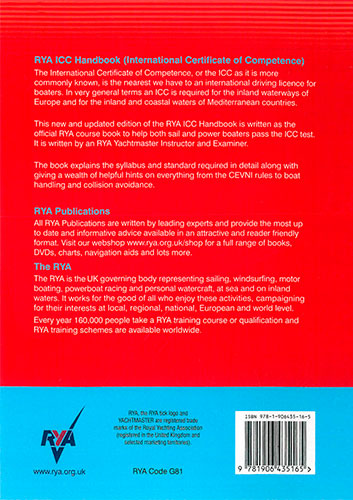Сб с 10 до 16
ICC Handbook (International Certificate of Competence)
Книга на английском языке.
In mainland Europe there is a certain type of official, usually with epaulettes, who will not let you pass in your boat unless you produce an International Certificate of Competence. For these retentive jobsworths even a Yachtmaster certificate is unacceptable; the ICC with its European wording and translations is the only certificate he recognises.
I always take my ICC when yachting in Europe even on coastlines where it is not strictly necessary. On inland waters it is definitely necessary and confirms the holder has passed a test on the Inland Waterways CEVNI regulations.
In 1998 when the UNECE Resolution 40 introduced the ICC, I was given the job of turning a fairly vague syllabus into an RYA assessment, and implementing it at over a thousand RYA recognised practical training centres. The assessment had to be accessible and achievable, but sufficiently rigorous to ensure that holders of the ICC can keep themselves out of trouble.
How this now works and how to obtain an ICC is explained in this book. If you are considering a trip to mainland Europe and need a certificate this book is a must. The syllabus and standard is explained in detail along with a wealth of helpful hints and information on everything from the CEVNI rules to boat handling and collision avoidance.
Rob Gibson, the author, is one of our most experienced instructors and examiners. When he took his Yachtmaster Instructor course his examiner described him as "an excellent instructor and boat handler and a pleasure to be with". You couldn't ask for a better tutor.
Contents
What is the ICC?
Eligibility
Categories of ICC
CEVNI
How to apply for an ICC Assessme
Exemptions
The Certificate
The assessment
The syllabus
Part A: Regulations
Keeping a proper lookout
Determine a 'safe speed'
Potential collision situation
'Give way' and 'stand on' vessels
Rules in narrow channels
Manoeuvring signals
Visual distress signals
Part A: Safety
Lifejackets and harnesses
Distress flares
Fire extinguishers
Kill cords
Engine checks
Fuel range/duration of trip
Avoid overloading boat
Obtain weather forecast
Part B: CEVNI
CEVNI regulations
Prohibitions
Other traffic lights
Mandatory
Restrictions
Recommendations
Authorisations
Indications
Daymarks and lights
Part С: Regulations
Traffic separation schemes
Navigation lights and shapes
Lights and sound signals
Part C: Pilotage
Buoys of the IALA system
Sources of information
Plan a harbour entry/departure
Part C: Navigation
Chart symbols
Charted depths and drying heights
Magnetic and True bearings
Magnetic course to steer
Tide Times and Height of Tide
Tidal Atlases and Rate of Flow
Global Positioning System (GPS)
Part 4: Boat Handling
Planning and briefing
Departing from a pontoon
360о turn in a confined space Securing to buoys
Man overboard (MOB)
Sailing cruisers
Yachts with large mainsails
Larger motorboats RIBs and small powerboats
Lifebuoys, danbuoys and lights
Recovery methods and treatment
High speed manoeuvres
Handling under sail
Coming alongside a windward pontoon
Glossary
Index





 Cruising under power
Cruising under power  Skipper's outboard motor guide
Skipper's outboard motor guide  Diesel companion
Diesel companion